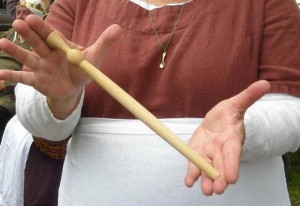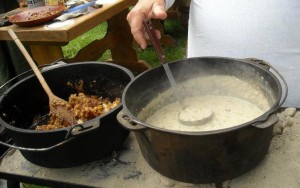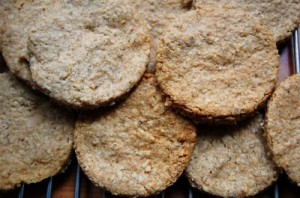At a recent SCA event, Cast Iron Chef Lyondemere 2012, I was asked to teach some kind of a cooking class or do a demo appropriate for the day. The scenario the contestants were given, for which they were to select their dishes, took place in early 14th century Scotland. Right up my alley!
I don’t get much chance to share my love for recreating the dishes Beathog may have eaten during this period, as I am precluded from making any public claims to their authenticity. With the lack of any physical evidence (such as actual period recipes), we (the SCA) apparently cannot be certain that the women (or men) of medieval Scotland cooked anything at all.
The first Scottish cookery book to be published was in the early 18th century, but we have plenty of period recipes from neighboring countries to compare, throughout the medieval period, that enable us to make an educated guess as to what Scotland may have been eating during the 14th century. And that certainly has to include oats, which remain a versatile and much-loved staple item today.
So, what follows is my own conclusion, and includes the oat recipes I share regularly with my household encampment and what I shared with the cold, the hungry and the curious on a very fun (and filling) morning in the Barony of Lyondemere.
History
Oats grew as a weed long before it was cultivated as a crop. The oldest cultivated oat crop found was in a Switzerland cave, and dates to the Bronze Age. There are more varieties of oats than can be counted. Most varieties have been used as a feed grain and used as bedding straw for livestock throughout history. It grows best in areas with a cool, moist climate — Scotland! In Samuel Johnson’s A Dictionary of the English Language, 1755, oats were defined as “eaten by people in Scotland, but fit only for horses in England.” The Scotsman’s retort to this is, “That’s why England has such good horses, and Scotland has such fine men!”
Along with barley, oats was one of Scotland’s main cereal crops during the Middle Ages. As Scotch whisky gained popularity, many farmers switched to growing spring barley for malting. But, oats remained the staple diet of the crofters, the tenant farmers in the Highlands, during the late Middle Ages. As there was no method of preserving the oats, a thick paste was made, cooled and then stored in a wooden porage drawer, from where it was eaten over several days. When cold, the mixture became thick and solid and useful in thick slices or fried.
Types of oats
We compared different types of oats available to us today. In the U.S., we eat rolled oats, familiar as Quaker Old-Fashioned or Quick Cooking Oats (which is merely processed a little finer, translating to a shorter cooking time). Scottish Porage Oats are rather similar but smaller in appearance. Scottish Pinhead Oats are my favorite, and what we serve in our camp. They are cut, rather than rolled, and similar in appearance to Irish Steel Cut Oats. They are much preferred, however, as they require no soaking before cooking, cook up much quicker, and leave no sticky, paste-y mess in the pan at cleanup time. And the drawback? I have been unable to find a U.S. distributor for Pinhead Oats (they used to be available at World Market), so must have them shipped to me from Scotland.
Whatever type of oats I use to make my porage, I use a heavy saucepan to cook them, and a traditional wooden spurtle to stir them.
 Oat milk can be made from any type of oats, just as one might make almond milk, by soaking the oats in water and then draining through a cheesecloth. I like to make it the fastest way, which is to add 1/2 cup oats to 4 cups water in a blender, allowing it to soak about 20 minutes. Blend until very smooth. Pour the oat milk through a fine mesh strainer and drink, or proceed with recipe!
Oat milk can be made from any type of oats, just as one might make almond milk, by soaking the oats in water and then draining through a cheesecloth. I like to make it the fastest way, which is to add 1/2 cup oats to 4 cups water in a blender, allowing it to soak about 20 minutes. Blend until very smooth. Pour the oat milk through a fine mesh strainer and drink, or proceed with recipe!
Atholl Brose
According to legend, the delicious drink is named after the 1st Earl of Atholl, who quashed a Highland rebellion in 1475, by filling the rebel leader (John, Lord of Isles)’s well with a mixture of brose (an uncooked form of porage, simply, oats and water), honey and whisky, making him easily captured!
The brose is prepared by steeping a volume of oatmeal overnight in 2-3 times as much cold water, then straining the liquid through cheesecloth or coarse linen, discarding the oatmeal. Alternatively, prepared oat milk may be used, and simply combined with honey and whisky. Cream is sometimes added for extra richness, particularly on festive occasions.
My recipe:
2 cups oatmeal
1 pint water
1/4 cup honey
1 pint Scotch whisky
1/2 pint cream (I like it in my coffee!)
Scotch Whisky
The earliest documented record of distilling in Scotland was an entry in the Exchequer Rolls in 1494:
“Eight bolls of malt to Friar John Cor wherewith to make aqua vitae“,
. . . sufficient amount to produce almost 1500 bottles! It appears that distilling was already a well-established practice, given the amount of malt to be used.
The Gaelic word for aqua vitae, meaning “water of life” is usquebaugh, which phonetically became “usky” and then “whisky” in English. Scotch whisky (and Irish whiskey) is distilled from a fermented mash of barley. (American and Canadian whiskeys, including bourbon, are made from corn, with the exception of Rye whiskey. Japanese whisky is made from a mixture of corn, millet and, sometimes, rice.)
According to legend, Saint Patrick introduced distilling to Ireland in the 5th century and the secrets traveled with the Dalriadic Scots when they arrived in Kintyre from Ulster, around 500 A.D. He acquired the knowledge in Spain and France, where the art of distilling was known. The distilling process was originally applied to perfume, then to wine, and finally adapted to fermented mashes of cereals in countries where grapes were not plentiful. The spirit was universally termed aqua vitae, and was commonly made in monasteries and chiefly used for medicinal purposes. It sure makes me feel better!
Oat flour
Oat flour can easily be made by grinding oats very finely (I used a food processor). The flour produces a denser loaf than fine wheat flour. I used a combination in my simple recipe, adding only yeast, a small amount of honey, water and salt to the flour mixture. The resulting loaves were tasty, albeit a little dense.
My recipe:
2 cups oat flour
2 cups unbleached wheat flour
1 Tbl yeast
1-3/4 cups water
1 tsp salt
1-1/2 tsp honey
Oat cakes
The long association of the Scottish hearth and flatbreads of both oats and barley has been well documented. Traditionally baked on a stone before the fire, the unleavened cakes were often laid there to dry out, rather than actually bake. The bakestone was eventually replaced by an iron girdle, and is still used today.
Historical accounts record the making of oatcakes by Scottish soldiers to, at least, the early 14th century. There are numerous published recipes for oatcakes and similar unleavened cakes during the medieval period, but none from actual Scottish cookery sources. It is certainly not a far reach to suppose they were being eaten in Scotland, as well!
As soon as you can grow barley you can make oatcakes;
these represent a truly ancient food.
There is really no recipe to make oatcakes; mix whatever dry ingredients you are using, cut in some kind of fat, if using, and moisten with enough water to form a ball or batter to your liking. Individual oatcakes can be made, or one large, round bannock can be made and cut in farls (fourths).
For the demo, I made three different recipes of oatcakes. For the first, I mixed oats with a small amount of salt and rendered bacon fat, flattened very thinly, and baked on my girdle. These were my dog’s favorite! I also made a batch with melted butter and grated cheese. This is not a far reach for Beathog, as cows were often kept in Scotland, especially by her husband’s clan, the Macfarlanes! I like the flavor (and texture) from the addition of the cheese. Each of the following recipes make 8-12 oatcakes:
2 cups medium oats
1 cup oat or wheat flour
1/4 cup rendered bacon fat (can also use lard or beef drippings)
1 tsp salt (optional)
1/2 cup porage oats
1/2 cup pinhead oats
1 cup grated aged cheddar cheese
1/3 cup melted butter
I also made a sweeter version, following a recipe given to me by a good friend, Mistress Medb Renata, years ago. These are a household favorite, and we make them as often as we remember to! I don’t feel at liberty to post the recipe here, as it is not my own. It does contain a small amount of leavening, a fair amount of fat, additional wheat flour, and the addition of honey, or sugar, for sweetening. Once you understand the basics of an oatcake, it really just is a matter of experimenting until you get something you and your friends will like. Once you have the right consistency, and the right sweetness, add a small pinch of baking soda and you will probably come closes to Mistress Medb’s own recipe. I don’t believe I follow it the way she wrote it anymore, but have added my own tastes to it. You really can’t go wrong. I don’t believe.
These sweet cakes are somewhat similar to a modern oatmeal cookie, just much more substantial! I believe they would last for years tucked into my own spice box, if they weren’t too delicious to save!
White Pudding
This was delicious! There isn’t much of a recipe to share; it’s so simple. I combined equal amounts of grated suet (you have to do this while it is frozen) and oats, added chopped onion and poudre forte to taste. I believe my proportions were:
2 cups grated suet
2 cups porage oats
1 onion, chopped
poudre forte, salt to taste (can use allspice, or a combination of equal amounts of cinnamon, nutmeg and cloves)
For white pudding, stuff mixture loosely into sausage casings; simmer until soft, pricking with a fork, if necessary, to avoid bursting. Allow to cool; slice, and brown in oil or fat.
Traditionally, white puddings were stored buried in oats! The are very popular, still, in Scotland. White puddings are made in England and Ireland, as well, but usually contain pork in addition to the oats. Scottish white pudding is simple and delicious!
Skirlie
Skirlie is nothing more than white pudding without the casing. Onions are fried in an amount of fat, then oatmeal is added, stirring constantly so it does not burn, and seasoned with a little salt and pepper. It is eaten and enjoyed as is, or used as a stuffing in meat or poultry dishes. It may be formed into balls and eaten with broth = broth and skirlie.
Haggis
I cannot mention the beautiful marriage between oats and onions without mentioning haggis. Now embraced as the national dish of Scotland, recipes for haggis can be found in English Cookery books as early as 1615, and food historians agree it was eaten long before that. What is it? Basically, it is the pluck of a sheep (containing the heart, liver and ‘lights’, or lungs) mixed with oats, onions and seasoning, stuffed into a sheep’s stomach. Yum! Actually, I tasted in, for the first time, on a bet, sitting in an Edinburgh pub with friends, and it is actually quite tasty! I brought canned haggis to the demo, and everyone who tasted it thought it was good, for a canned meat product, at any rate.
For the non-adventurous, uncooked oatmeal makes a good addition (replacing bread or cracker crumbs) to any meatloaf recipe!
All the oats dishes were well received at the demo. But, by far, there were two daily winners, which I will attempt to share, below. Leek & Oatmeal Broth is something I make all the time for our encampment at SCA wars. Oat Crumble is something that I will be making (all the time) for our encampment at SCA wars (now that household members have tasted it! (It was especially popular with a dousing of Atholl Brose on top.) The recipes (to the best of my ability, as I really don’t use exact recipes) follow:
Leek & Oatmeal Broth
6 leeks (washed well and thinly sliced)
1 onion, chopped
handful of celery (optional, I use it if I have some that needs to be used)
1 stick butter
salt & pepper to taste
pinch of mace
2 qt stock or broth (I use homemade vegetable stock, but chicken broth can be used, as well)
up to 2 cups pinhead oats, or regular oats okay
1 qt whole milk or oat milk can be added for extra richness
chopped parsley (optional)
 Cook leeks, onion and celery in butter until soft. Season well, and add your choice of broth. Add the uncooked oats and simmer for about 30 minutes. Stir in your choice of milk, and check the seasoning. Add more stock or milk if soup becomes too thick (it will be thicker when it is cool, but thin out when heated).
Cook leeks, onion and celery in butter until soft. Season well, and add your choice of broth. Add the uncooked oats and simmer for about 30 minutes. Stir in your choice of milk, and check the seasoning. Add more stock or milk if soup becomes too thick (it will be thicker when it is cool, but thin out when heated).
If you make your own stock or broth, this is a very economical dish to serve large groups.
Oat Crumble
Filling: combine, put in oiled baking dish (I used a Dutch oven; see photo, above):
10-12 Granny Smith apples, peeled and sliced
2 Tbl lemon juice, to coat apples and keep from browning
1-1/4 cups brown sugar
1/3 cup flour
2 tsp cinnamon
3/4 tsp nutmeg
1/4 tsp ground cloves (optional, I did not use)
3/4 tsp salt
Topping (combine and spread on top of apple mixture):
2 cups brown sugar
2 cups flour
1 cup oatmeal
1/2 cup chopped walnuts (optional, but good!)
1 cup butter, melted
This is not a period recipe, but there are published recipes in period that are very similar. The apples Beathog would have found in Scotland would not have been sweet, so would either be used for cider, or would be cooked and sweetened.
I baked this recipe, using a 12″ Dutch oven, for about an hour, with 12-14 coals on the bottom and 16-18 on top. It can also be baked in an oven (whatever that is). Enjoy!
◊◊◊
Many thanks to Lady Catharine Hawkwod da Barbiano and the Barony of Angels for some of the photos I used,
 especially this one of Fionnlagh Reamhar Cu Cliaranach, shown here with a very full, happy tummy — after finishing off the bacon oatcakes!
especially this one of Fionnlagh Reamhar Cu Cliaranach, shown here with a very full, happy tummy — after finishing off the bacon oatcakes!


